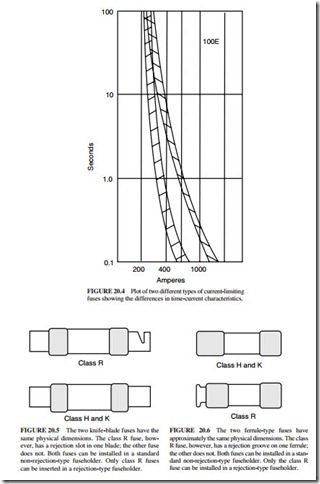FEATURES OF CURRENT-LIMITING FUSES
Current-limiting fuses are fully rated to withstand moderate overloads without damage or a change in characteristic. Current-limiting fuses are generally used in motor starters and low-voltage circuit breakers to protect the motor contacter or circuit breaker from destruction when subjected to fault-current magnitudes in excess of their interrupting rating.
When current-limiting fuses are used, the NEC requires that “Fuseholders for current- limiting fuses shall not permit insertion of fuses that are not current-limiting” (Art. 240-60). Therefore, the fuse holder which will take class R fuses must be used. Class R fuses provide high degree of current limitation with interrupting current capability of up to 200,000 A.
This interrupting current rating distinguishes class R fuses, from class H fuses, which have an interrupting rating of only 10,000 A. Class K fuses (K-1, K-5, and K-9) have an interrupting rating as low as 50,000 A. Figures 20.5 and 20.6 illustrate the differences in con- struction of these fuses.
FUSES 20.5Medium-voltage motor controllers are fault-protected by high-interrupting-capacity, current-limiting fuses. Backup R-rated fuses are especially designed for motor service with capability of carrying high starting currents during prolonged acceleration without fuse deterioration or nuisance blowing. These fuses do not have actual current ratings. However, they have application designations with typical melting time, total arc clearing time, and current-limiting characteristics.
